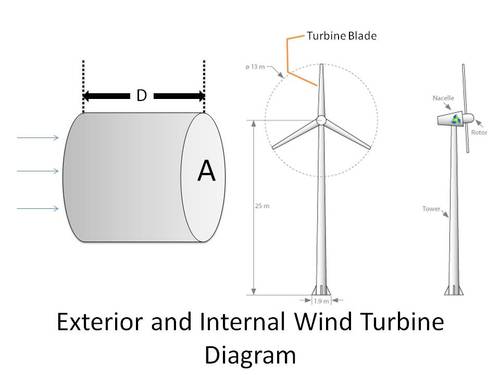Wind Engineering Power!
 Now, let's delve deeper into the delicate engineering of
wind power
.
(You may want to refer to the wind power note to have a clearer idea on wind energy)
Now, let's delve deeper into the delicate engineering of
wind power
.
(You may want to refer to the wind power note to have a clearer idea on wind energy)
The diagram above shows how a wind turbine is used to produce electricity in a typical power station both internally and externally. The wind turns the wind turbines which are connected to a generator to generate electricity.
One day, An physicist, James Prescott Joule who came up with The Principle of Conservation of Energy has risen from the grave near a wind power station. He then saw a majestic wind turbine and discovered that the power available to a wind turbine depends on the kinetic energy of a column of air with the same cross sectional area as the wind turbine blades.
As James had risen from the grave, he had the capability of observing that the steady supply of strong wind is necessary to use the power in the wind. Modern wind turbines are designed to operate when the speeds are within the domain, to . Many wind turbines are designed to remain stationary when the wind speed is below .
Hence, determine the available power from the Wind if the wind speed is at its minimum for the turbines to operate. James Prescott Joule : Can you figure it out?
Details :
-
Assume that the density of air is .
-
Assume that the wind blades have a length of . Do not use the length given by the diagram, it's just for visualization.
-
Round your answer off to .
-
This is part of the set, Beauty of the natural wind, #MajesticWind.
The answer is 9.1E+5.
This section requires Javascript.
You are seeing this because something didn't load right. We suggest you, (a) try
refreshing the page, (b) enabling javascript if it is disabled on your browser and,
finally, (c)
loading the
non-javascript version of this page
. We're sorry about the hassle.
Given the above information, you would have to find the available power of the wind by re-synthesizing a brand new equation from classical mechanics formulas in order to relate with the density of air and the wind's velocity. So, by considering the volume of air entering a wind turbine of a particular thickness, d and the cross-sectional area, A, we can begin proving.........
Using P= t E ,
After which, we simply substitute the required values and we are done!
Bonus: This equation helped me to solve the 'lazy day' problem by David Mattingly.